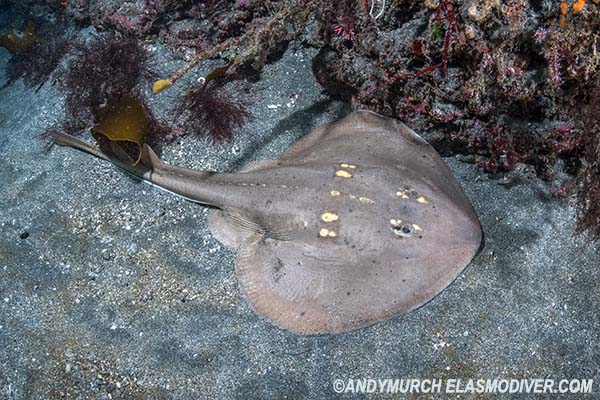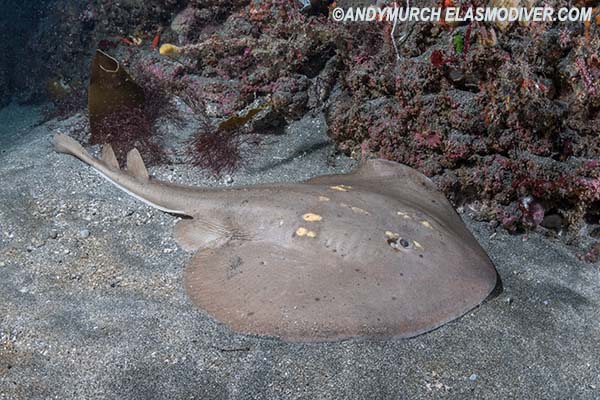|


View all available
Yellowspotted Fanray images
in the Shark Picture Database.
Common
English Names: Yellowspotted Fanray, Tang's Fan
Ray, Yellow Spotted Fan Ray.
Scientific
Name: Platyrhina tangi.
Family:
Platyrhinidae - containing 2 genera and 5 described species.
Thornback rays look superficially similar to guitarfishes but they
are more closely related to stingrays.
Identification:
Spade
or heart shaped disc, slightly wider than long
with convex anterior margins. Long, broad tail tapering into a well developed
caudal lobe. Two relatively large, rounded dorsal fins beginning
midway along tail. A single row of pronounced, weakly hooked thorns/tubercles
runs centrally along dorsum from mid back to caudal lobe.
Dorsum uniformly light to dark brown or greyish-brown.
Often with a few small, randomly positioned, dark freckles on disc.
One elongated yellow spot is present in front of each eye. Two are
present behind eye adjacent to spiracle. At mid back, Two pairs of
yellow spots branch laterally on either side of center line forming
a 'yellow cross' when viewed from above. Ventrum pale.
Spiracles small - roughly eye-sized.
Size:
Maximum
recorded length at least 64cm, possibly exceeds 70cm.
Habitat:
Little known. Seen by divers in Japan on sandy bottoms around
rocky reefs at 20m.
Distribution:
Northwestern Pacific from Northern Vietnam to Japan
including Taiwan, Mainland China and South Korea. Absent from the
Ryukyu Archipelago in western Japan.
Reproduction:
Thornback rays are ovoviviparous (yolk
sac viviparity). The
yellowspotted fanray gives birth between August and November.
Conservation Status: The yellowspotted fanray
has yet to be assessed by the IUCN. However, it probably faces the
same fishing pressure as the closely related Chinese Fanray
Platyrhina sinensis which shares much of its range. The
latter has been assessed as VULNERABLE. The Chinese Fanray is taken
as utilised bycatch in gillnet, coastal set-net, trawl fisheries,
and almost all fishery types operating in shallow waters (Y. Wang
pers. obs.). All bycatch is utilised in some areas of the species
range, whereas it is discarded in other areas (Y. Wang pers. obs.,
Yamaguchi unpublished data). Yamada et al. (2007) report that this
species was formerly caught by bottom trawl fisheries in the East
China Sea, but has declined both in terms of abundance and extent of
occurrence. However, in Shimoda, Izu Peninsula, southern Japan (at
the northern extent of this species range), it is reportedly still
common (S. Tanaka pers. comm.). Historical fishing pressure has been
high throughout the much of its range and exploitation is continuing
in many areas of this species inshore habitat. For example, fishing
pressure on batoids is intensive in the South China Sea. Its
preference for shallow waters and slow movement mean it is easily
captured in demersal fisheries and vulnerable to depletion.
Photographs:
Tateyama in Chiba Prefecture, Southern
Honshu, Japan.
Similar
species: The closely related Chinese Fanray
Platyrhina sinensis shares most of the Yellowspotted Fanray's
range.
It can be distinguished by the lack of pronounced tubercles behind
its eyes and the row of thorns running along its midline which
branches into two widely spaced lines beyond its tail base.
Reaction
to divers: Generally easy to approach with slow movements.
Fanrays rarelybolt in the presence of divers.
Diving logistics: This species can sometimes be found mixed
in with the red stingrays at shark feeds in Tateyama, Japan. Big
Fish Expeditions runs Shark Diving trips to Japan that include dives
at Tateyama:
Japan Shark
Diving Safari
Citation:
Ishihara, H., Wang, Y., Tanaka, S. & Nakaya, K.
2009. Platyrhina sinensis. The IUCN Red List of Threatened
Species 2009: e.T161589A5458790. http://dx.doi.org/10.2305/IUCN.UK.2009-2.RLTS.T161589A5458790.en.
Downloaded on 19 October 2017.
|























